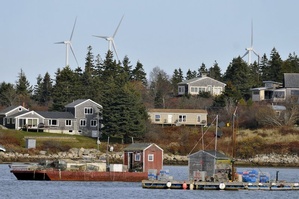State reports recommends 1000 foot wind farm setbacks in Maine
Human impacts, News, Wind turbines Add comments
Maine’s Office of Energy Independence and Security has delivered a long-awaited report on wind farm siting to the state legislature. The lead recommendation is that the minimum distance between commercial wind turbines and residences be nearly doubled, to 1000 feet; current standards are based on safety, not noise, while the proposed increase is meant to address noise impacts. It appears that the 1000 foot distance is based on keeping noise levels below 55dB during the day and 45dB at night, which is what is required for all noise sources in rural Maine.
The proposal was met with resistance from both sides. Jeremy Payne of the Maine Renewable Energy Association said the new setback is arbitrary, and that “we’re comfortable that the existing setbacks are protective of public safety and health.” Karen Bessey Pease of Friends of the Highland Mountains, which has been proposing one-mile setbacks, said that 1000 feet is “just too little to protect citizens.” David Wylie of Vinalhaven (image above) was more blunt: “One thousand feet is really ludicrous. We’re 2,400 feet away and it’s really unbearable. It shakes the house and goes through our bones and bodies.”
Here at AEI, we noted that the experts consulted for the report did not include any acousticians who have suggested that lower noise limits may be necessary for wind farms than for other noise sources. We were pleased and somewhat surprised to see AEI cited numerous times, though in some cases our points were taken partially out of context and some points which were accurately presented were apparently ignored in coming to the conclusions. In particular, we were pleased to see that the report included our assessment of peer-reviewed Scandinavian studies that suggest that when wind turbine noise tops 40dB, annoyance spikes in rural areas to 25-45% of those hearing these levels – though of course the 1000 foot setback guarantees that many of the closest neighbors will indeed be disturbed (it’s likely that those from 1000 to at least 3500 feet will regularly hear noise levels of over 40dB). Two citations of our work implied that very few wind farms cause noise issues, but left out the fact that this is because most are far from homes and that a much larger proportion of wind farms within a half mile or mile of homes do cause problems, especially in rural areas that are not working farm and ranch landscapes. Likewise, a citation suggesting that “Typically, between 5-20% of people, with higher levels of around 20% of people in rural areas, are highly annoyed by wind turbine noise” neglected to note these figures are for all those who can hear turbines at any volume or distance; again, the key point is obscured: that those within a half mile or so are apparently negatively impacted at a high rate, and those within a mile or so also likely to be more bothered. Even overlooking the subtle misinterpretation, I am left to wonder: is this report suggesting that causing a high level of annoyance in 20% of the rural population an acceptable outcome? As noted by many acousticians, community noise standards are typically set to minimize negative impacts more effectively than that.
Read more at the Portland Press Herald, or: Download the full report.
